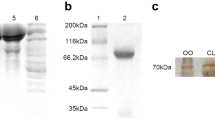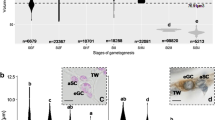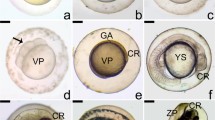Abstract
The temporospatial distribution of bovine primordial germ cells was studied in 34 embryos (18 to 39 days). For a reliable identification of bovine primordial germ cells in varying localizations and at different developmental stages the alkaline phosphatase reaction combined with the use of selected lectins was applied. The first potential primordial germ cells were identified in an 18-day-old trilaminar embryo in the caudal wall of the proximal yolk sac at a distance of less than 100 µm from the germ disc. These cells are alkaline phosphatase-positive, but do not yet react with lectins. From 18 through 23 days, morphogenetic folding converts the flat trilaminar disc into a cylindrical embryonic body. During this folding process primordial germ cells located in the proximal yolk sac area are incorporated into the embryo when this portion of the yolk sac becomes the hind- and mid-gut. Consequently, in 23- to 25-day-old embryos putative primordial germ cells (alkaline phosphatase- and lectin-positive) are situated predominantly in the axial body region at the level of the mesonephros. When the gonadal ridge develops in this region (about day 27) it contains a certain number of primordial germ cells present from the very beginning. Thus, the assumptions of a long-range chemoattraction of primordial germ cells by the gonadal ridge, of active immigration from an extraembryonic site, or of a passive transportation via the blood stream are not necessary to explain the initial settlement of bovine primordial germ cells in the gonadal ridge. Within the gonadal ridge (days 27–31) and later in the still sexually indifferent gonadal fold (32–39 days) the primordial germ cells are unevenly distributed. Extra-gonadal potential primordial germ cells (alkaline phosphatase-positive, but with reduced or no lectin staining) are regularly present in large numbers in bovine embryos with indifferent gonads. Such cells occur predominantly in the paraaortal tissue and in the liver, but also in the branchial arches. The different locations of extragonadal primordial germ cells are discussed in the light of recent evidence that germ cells and haematopoietic cells share common ancestors.
Similar content being viewed by others
Author information
Authors and Affiliations
Additional information
Accepted: 26 January 1998
Rights and permissions
About this article
Cite this article
Wrobel, KH., Süß, F. Identification and temporospatial distribution of bovine primordial germ cells prior to gonadal sexual differentiation. Anat Embryol 197, 451–467 (1998). https://doi.org/10.1007/s004290050156
Issue Date:
DOI: https://doi.org/10.1007/s004290050156




